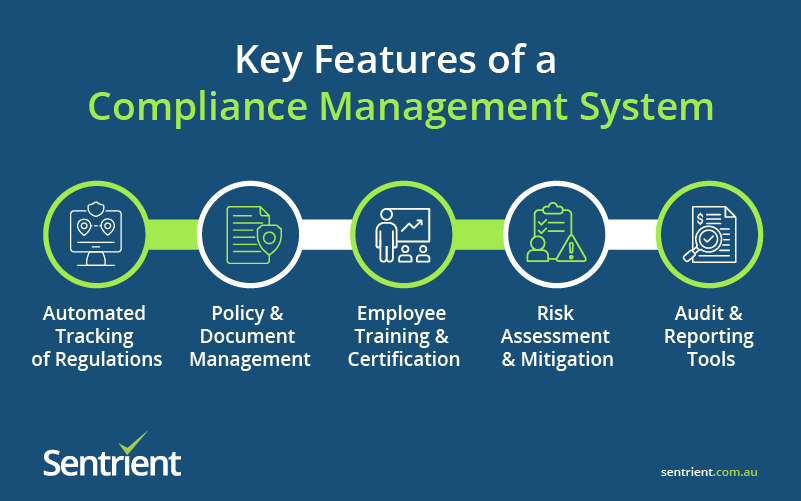Australian businesses may face huge fines if they fail to comply with regulations. With multiple laws and industry standards, keeping track can be overwhelming – especially for companies with large teams and extensive operations. Without the right system, staying compliant becomes a constant challenge.
We understand the complexities businesses face in meeting compliance requirements. A Compliance Management System (CMS) streamlines the process, helping you avoid costly penalties. With automated tracking and real-time documentation, your compliance efforts become more reliable and efficient.
What is a Compliance Management System?
A Compliance Management System (CMS) is a structured approach to ensure your business meets regulatory requirements, internal policies, and industry standards. It integrates tools, processes, and controls to help organisations manage compliance seamlessly.
Compliance management systems guide your business through complex regulations while ensuring employees stay informed and operations remain compliant. It consists of three key components:
- Board and management oversight
- Compliance program implementation
- Compliance audit processes
A reliable Compliance Management System automates compliance tasks, identifies potential issues in real time, and standardises processes across industries. It continuously updates to reflect new regulations, reducing risks and ensuring your business stays ahead.
Modern systems also feature advanced automation that detects risks early and enables quick corrective actions – significantly lowering the chances of compliance breaches.
Why Compliance is Important for Australian Businesses?
Australian businesses must follow strict laws, regulations, and ethical practices to remain operational because non-compliance can be risky and expensive.
Companies and sometimes individuals can face enormous fines for non-compliance. These penalties reflect the government’s strong commitment to regulatory enforcement.
The Australian Competition and Consumer Commission (ACCC) enforces compliance by:
- Ensuring fair trading practices
- Protecting consumer rights
- Promoting competitive business environments.
Staying compliant helps your business maintain credibility, avoid financial risks, and build stronger customer trust. Failing to comply may result in penalties, damage your reputation and lead to legal complications.
Compliance requires continuous monitoring and adaptation to new laws and industry changes.
Key Features of a Compliance Management System
Modern CMS solutions come equipped with features that simplify compliance and reduce risks.

1. Automated Tracking of Regulations
A centralised regulation library updates in real-time, ensuring businesses stay aligned with evolving industry standards. Standardised workflows streamline compliance tasks, reducing manual errors.
2. Policy and Document Management
A policy management library automates document updates, approvals, and version control. This eliminates manual tasks and ensures all employees have access to the latest policies.
3. Employee Training and Certification
A structured training system automates course enrolments and sends reminders for certifications. This ensures employees stay informed and compliant.
4. Risk Assessment and Mitigation
Risk assessment tools identify compliance gaps and evaluate existing controls. Businesses can prioritise risks based on severity and take proactive measures.
5. Audit and Reporting Tools
A stable audit system tracks compliance status in real time, generates reports, and ensures proper documentation. Custom dashboards help teams stay updated on critical compliance tasks.
How a Compliance Management System can Help Australian Businesses Avoid Regulatory Fines?
Implementing a compliance management system gives businesses a competitive edge while ensuring regulatory compliance. Here’s how it prevents costly fines:
1. Ensures Proactive Compliance
A compliance management system monitors regulatory changes and alerts key personnel, allowing businesses to adapt before compliance issues arise. This reduces risks and ensures up-to-date compliance.
2. Reduces Human Error
Even the most experienced employees make mistakes. A compliance management system automates routine compliance tasks, minimising human errors and preventing violations due to oversight.
3. Improves Employee Accountability
A compliance management system assigns clear roles and responsibilities, tracks policy interactions, and ensures employees understand compliance expectations. Integrated training modules create a culture of responsibility.
4. Streamlines Documentation
Digital document management makes record-keeping effortless, simplifying audits and compliance verification. Key features include:
- Tracking policy acknowledgments
- Storing training certifications
- Recording compliance activities
- Generating audit-ready reports
5. Boosts Risk Management
By identifying compliance risks before they become violations, a compliance management system helps businesses implement preventative measures and maintain regulatory integrity.
Conclusion
Regulatory compliance is a critical challenge for Australian businesses. Without a structured system, companies risk heavy penalties and operational disruptions.
Sentrient’s Compliance Management System helps businesses stay ahead of compliance risks. More than just avoiding fines, our system enhances accountability, reduces human errors, and strengthens compliance frameworks.
Connect with our compliance experts and safeguard your Australian business with Sentrient’s Compliance Management System.
Get in Touch to learn more!
FAQs
1. What is the main purpose of a Compliance Management System (CMS)?
A Compliance Management System ensures businesses meet regulatory requirements by automating compliance processes, reducing risks, and managing policies efficiently.
2. How can a compliance management system help Australian businesses avoid regulatory fines?
A compliance management system tracks regulations, reduces human errors, improves accountability, streamlines documentation, and strengthens risk management.
3. What are the potential consequences of non-compliance for Australian businesses?
Non-compliance can result in severe financial penalties and legal actions that damage business credibility.
4. What key features should a Compliance Management System include?
A reliable Compliance Management System offers automated tracking, policy management, employee training, risk assessment, and audit tools to ensure full compliance.
5. How does a compliance management system improve employee accountability in terms of compliance?
A compliance management system clearly defines roles, tracks compliance activities, and integrates training modules to ensure employees stay informed and responsible.






